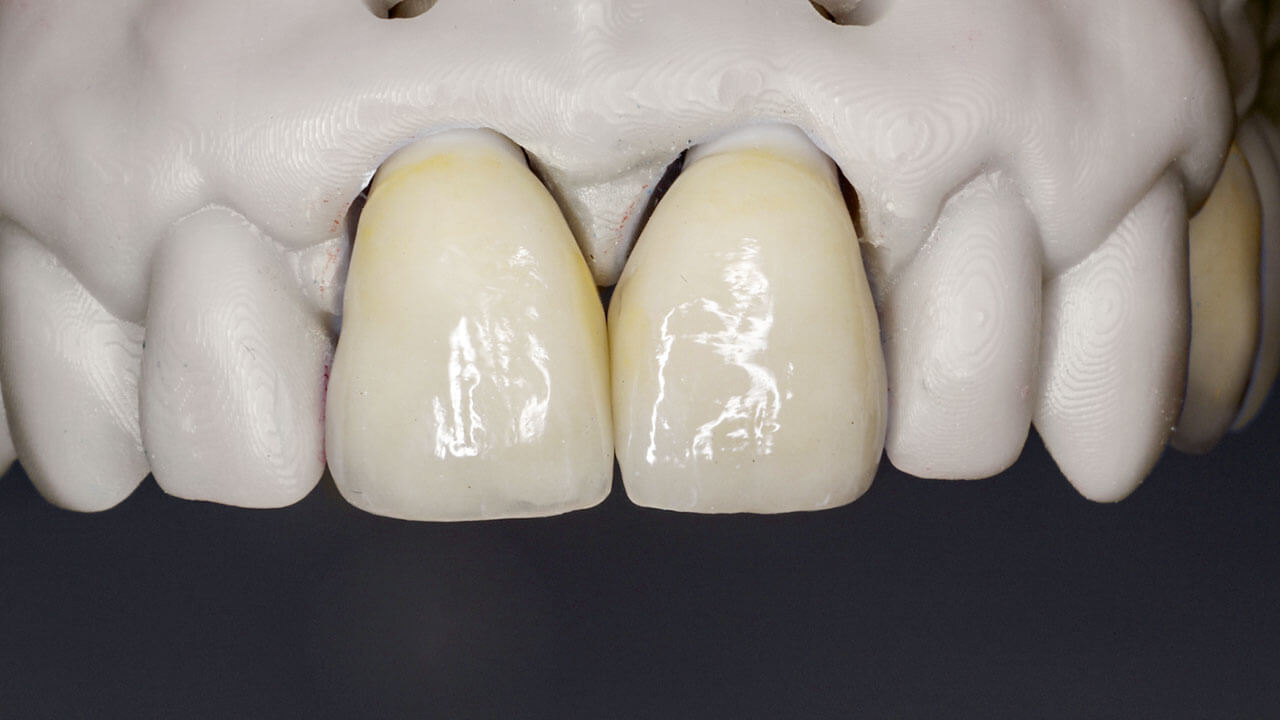Implantologie, 1/2025
Pages 79-89, Language: GermanKniha, Kristian / Wolfart, Stefan / Elvers, Dirk / Hölzle, Frank / Modabber, AliDie zunehmende Verwendung dentaler Implantate führt zu einer steigenden Anzahl an Komplikationen und Misserfolgen. Ziel dieser Arbeit ist es, die aktuell verfügbaren Techniken zur Entfernung osseointegrierter Implantate hinsichtlich des Erfolgs der Explantation, der Komplikationen und des Knochenverlusts zu beschreiben. Das umgekehrte Drehmoment ist laut aktueller Literatur die konservativste Methode und sollte die erste Wahl für die Explantation sein. Jedoch kann diese Methode nicht in jedem Fall angewendet werden und eine Kombination aus verschiedenen Techniken erforderlich sein. Eine wirksame, konservative und wirtschaftliche Explantationstechnik ist notwendig, um eine Neuversorgung mit Implantaten zu ermöglichen. Neue Ansätze beschäftigen sich mit der Osseodisintegration der Implantate, ein Verfahren, das durch thermische Reize induziert werden kann.
Keywords: Osseodeintegration, Zahnimplantate, Explantation, Implantatentfernung, gescheiterte Implantate
Implantologie, 2/2021
Pages 173-180, Language: GermanKniha, Kristian / Meindl, Robert L. / Schlegel, Karl Andreas / Kniha, HeinzEin Fallbericht über die Verwendung beider MaterialienIn den letzten Jahren hat sich Zirkoniumdioxid zu einem alternativen Implantatmaterial entwickelt. Im Vergleich zu Titanimplantaten ist das Angebot jedoch bis heute limitiert. Die Hauptindikation keramischer Implantate könnte vor allem im ästhetischen Bereich liegen, da in aktuellen Studien eine signifikante Papillenvermehrung ausgewertet werden konnte. Dagegen überzeugen Titanimplantate hinsichtlich Portfoliogröße und Langzeitdaten. Mit beiden Materialien lassen sich dauerhafte und erfolgreiche Patientenversorgungen erzielen. Je nach Ausgangssituation und Patientenwunsch sollten beide Konzepte individuell abgewogen werden.
Manuskripteingang: 01.03.2021, Annahme: 03.03.2021
Keywords: Titan, Zirkoniumdioxid, dentale Implantate
International Journal of Periodontics & Restorative Dentistry, 5/2019
Online OnlyDOI: 10.11607/prd.3282, PubMed ID (PMID): 29897352Pages e105-e201, Language: EnglishKniha, Kristian / Kniha, Heinz / Grunert, Ingrid / Edelhoff, Daniel / Hölzle, Frank / Modabber, AliThe purpose of this study was to evaluate ceramic dental implants using different esthetic scores. A total of 53 ceramic dental implants were evaluated using the Pink Esthetic Score (PES), White Esthetic Score (WES), and Peri- Implant and Crown Index (PICI). Prosthodontists, orthodontists, oral surgeons, and dentistry students independently performed assessments. The mean value of combined PES + WES was 17.4 points, and the PICI was 523.2 points. Orthodontists assessed a significantly lower result in both indices compared to all other assessor groups (P ≤ .05). Patient satisfaction was very high. The esthetic scores around ceramic implants were considerably higher than the suggested threshold of clinical acceptability.
Quintessenz Zahnmedizin, 11/2019
ImplantologiePages 1298-1307, Language: GermanKniha, Kristian / Heitzer, Marius / Peters, Florian / Katz, Marie Sophie / Möhlhenrich, Stephan Christian / Hölzle, Frank / Modabber, AliAuch wenn Langzeituntersuchungen nötig sind, um gesicherte Aussagen über die klinische Bewährung von Zirkonoxidimplantaten nach längerer Liegedauer treffen zu können, lässt sich auf der Grundlage des heutigen Erkenntnisstandes feststellen, dass diese Implantate eine Alternative zu herkömmlichen Titanimplantaten sein können. Ihre keramische Oberfläche bietet gerade im Weichteilbereich die Möglichkeit, ästhetisch sehr ansprechende Versorgungen zu generieren. Einteilige Implantate, wie sie zunächst gefertigt wurden, werden mittels Zementierung prothetisch versorgt. Zweiteilige Implantate der neueren Generation erlauben auch verschraubte Verbindungen zwischen Zahnersatz und Implantat. In der wissenschaftlichen Literatur zu Titanimplantaten geht man davon aus, dass keines der beiden Implantatdesigns gegenüber dem anderen einen signifikanten Vorteil für die Patienten hat, sondern dass jede Implantatform durch individuelle Vor- und Nachteile gekennzeichnet ist. Für zweiteilige Zirkonoxidimplantate stehen mittel- und langfristige klinische Daten noch aus. Der Beitrag beschreibt anhand von zwei Patientenfällen die klinische Anwendung ein- und zweiteiliger Zirkonoxidimplantate.
Keywords: Zirkonoxidimplantate, Titanimplantate, Implantatdesign, Gingivaformer, Papillen
Implantologie, 4/2018
Pages 375-380, Language: GermanKniha, Kristian / Schlegel, Karl Andreas / Kniha, Heinz / Hölzle, Frank / Modabber, Ali / Kniha, KimZiel der Studie war die Auswertung der interdentalen Papillenhöhe bis zu 3 Jahre Follow-up nach prothetischer Implantatversorgung. Zudem wurde der Einfluss des dicken oder dünnen gingivalen Biotyps auf das Weichteilverhalten analysiert. Es konnten 39 Personen mit 40 Zirkondioxidimplantaten (ZrO2) in der prospektiven Studie untersucht werden. Die Messkonzeption beinhaltete die Vermessung der Papillen-Kronen-Relation, welche nach prothetischer Versorgung (3 Monate nach Implantation), nach 1 Jahr und nach 3 Jahren erfasst wurde. Die Vermessung erfolgte anhand klinisch standardisiert aufgenommener Bilder. Für die Gesamtheit der Patienten zeigte sich eine signifikante Verbesserung der Papillen-Kronen-Relation von 35,5 % nach 3 Monaten auf 41,7 % nach 3 Jahren. Die Auswertung des gingivalen Biotyps wies eine moderate negative Korrelation in Bezug auf das Weichteilverhalten auf (Spearman's rho = -0,57). Zwischen 3 Monaten und 1 Jahr wurde eine signifikante Vermehrung der Papille im Interdentalraum erfasst (p 0,001).
Keywords: Papille, Zirkondioxid, dentale Implantate
The International Journal of Oral & Maxillofacial Implants, 1/2018
DOI: 10.11607/jomi.5598, PubMed ID (PMID): 29028851Pages 217-222, Language: EnglishKniha, Kristian / Milz, Stefan / Kniha, Heinz / Nassim, Ayoub / Hölzle, Frank / Modabber, AliPurpose: No consensus regarding the efficacy of zirconia implants in maintaining peri-implant hard and soft tissue health has yet been obtained. The aim of this retrospective follow-up study was to gain knowledge about peri-implant bone behavior and about implant survival and success after treatment with zirconia dental implants in patients with normal and compromised soft and hard tissue conditions.
Materials and Methods: This follow-up study involved 86 patients with 123 zirconia implants (Straumann PURE Ceramic Implant) that were radiographically investigated directly after implant placement (day 0), 3 months after placement, and 1 year after the definitive implant crown placement. The clinical assessment was done at the 1-year postloading appointment and also included the modified Plaque Index, modified Sulcus Bleeding Index, and sulcus pocket depths. Eighteen patients with periodontally compromised conditions were compared to 68 patients with healthy periodontal conditions.
Results: The survival rate was 100% and success rate was 94.5%, with no differences between the two groups. The alveolar crest around the ceramic implants showed no significant difference between day 0 and 1 year postloading for both groups (P > .05). There was also no significant difference at 1 year postloading between the groups in the distance from the implant shoulder to the peri-implant bone crest (P = .67) or in pocket depth (P = .07).
Conclusion: No significant peri-implant bone loss was observed in the first year. The survival and success rates showed no differences between the periodontally healthy and periodontally compromised groups; however, only a limited number of patients with periodontally compromised conditions were included in this study.
Keywords: alveolar crest, esthetics, gingiva, zirconia implants
International Journal of Oral Implantology, 4/2017
PubMed ID (PMID): 29234751Pages 443-451, Language: EnglishKniha, Kristian / Möhlhenrich, Stephan Christian / Lautner, Nora / Kniha, Heinz / Foldenauer, Ann Christina / Hölzle, Frank / Modabber, AliPurpose: To evaluate a possible association between the inter-implant distance and the papilla deficit. Additionally, the effect of high or low contact points of the crowns on the papilla deficit was investigated.
Materials and methods: Periapical radiographs taken 1 year after loading were used to assess the distance from the shoulder of the implant to the adjacent tooth or implant. On the clinical images, the interdental papilla height, soft tissue deficit and crown length were evaluated. The papilla crown proportion and the proportion of the height of the contact point to the crown length were assessed.
Results: Eighty-one patients, with a total of 104 zirconia implants and 208 measurements were involved in this cross-sectional survey. Considering patient means, the correlation between the papilla deficit and the interproximal distance, respectively inter-implant distance, was very low (r = -0.05220; P = 0.6435, N = 81). Logistic regression at implant-level showed that there was no significant difference in the likelihood for a papilla deficit between a high and a low contact point of the crowns with P = 0.8191 (Odds ratio: 1.106 with 95%CI 0.461; 2.654).
Conclusions: Horizontal interproximal dimensions around zirconia implants showed very weak influence on the papilla height. A high or a low contact point position of the crowns did not affect the papilla deficit.
Keywords: alveolar crest, dental implant, papilla, radiograph, zirconia
Conflict of Interest and sources of funding: All authors reported no conflict of interest. There were no sources of funding for the research.




